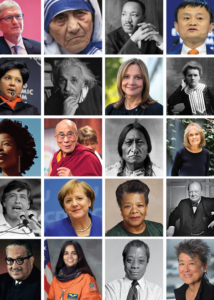- Featured
- Insigniam Perspectives
- IQ Insigniam Quarterly® Magazine
- The Changing Paradigm for Leadership
- Transformational Leadership
Would You Recognize a Leader if You Heard One?
Close your eyes and imagine what a leader looks like. Did you picture a man or a woman? A person of color? Perhaps a historical figure? If we were to collect responses and put them into a hat, chances are the mosaic that results would be a rich tapestry of human beings with wildly dissimilar backgrounds, experiences, and appearances.
The world has witnessed a profound transformation in leadership approaches over the past decade. From hierarchical structures to decentralized networks, from authoritative decision-making to collaborative and inclusive processes, the paradigm—or way we view leadership— has undergone a remarkable evolution. From Henry Ford to Mary Barra, if you will.
The evolving nature of enterprises across the global business landscape means that leadership requirements are constantly shifting, as well. Great leaders must adapt to changing circumstances and possess the agility to lead in dynamic environments. Identifying individuals who can meet these evolving demands adds to the difficulty of identifying good leaders. Even more difficult, perhaps, is the ability to identify these qualities in ourselves.
Within the corporate realm, the traditional top-down leadership model—characterized by a single individual wielding power and authority—has gradually given way to a more fluid and adaptive style. Intangible qualities such as emotional intelligence, adaptability, and ethical decision-making are now a requisite.
From COVID disruptions to supply chain disasters, many leaders are adapting to our new and still-emerging reality. Yet, if the future is to be realized, evolving our paradigms for leadership could be the catalyst to achieving our intended outcomes.
According to Stephen Covey, the author of The 7 Habits of Highly Effective People, “If you want small changes, work on your behavior; if you want quantum-leap changes, work on your paradigms.”
In tomorrow’s world, the most effective leaders behind “quantum-leap changes” will be those who position themselves to inspire and empower their teams, drive organizational success, and make a meaningful impact on their organizations and society as a whole. So how do we get there—and what factors are creating seismic shifts for leaders around the globe?
Surveying the Shift
If the paradigm for leadership is changing, then what is driving the shift?
The advent of globalization, technological advancements, and an increasingly interconnected world have contributed to a shift in societal values, expectations, and demands. As a result, a leader is now expected to possess a broader skill set that encompasses empathy, adaptability, and the ability to navigate complexity.
Furthermore, the rise of social media platforms has amplified the voices of individuals and communities, giving them a platform to express their opinions and influence public discourse.
In our digital age, knowledge is no longer confined to a privileged few but accessible to the masses. This free flow of information has empowered individuals, enabling them to challenge traditional power structures and demand transparency and accountability from their leaders.
This has led to a more participatory and inclusive form of leadership, where leaders actively seek input and engage with diverse perspectives. Inclusion and diversity are no longer mere buzzwords but integral components of effective leadership, fostering innovation, creativity, and resilience.
This degree of leadership engagement can pay dividends, says former PepsiCo CEO Indra Nooyi, “If you want to improve the organization, you have to improve yourself and the organization gets pulled up with you.”
Additionally, the rapid pace of technological advancements has also catalyzed a transformation in leadership. Automation and artificial intelligence have disrupted industries, challenging leaders to reimagine their roles and responsibilities. The ability to navigate through digital transformations, harness data-driven insights, and cultivate a culture of continuous learning has become critical for success. A leader must also grapple with the ethical implications of emerging technologies, ensuring that innovation aligns with human values and societal well-being.
Another significant aspect of the evolving leadership paradigm is a growing recognition of the importance of emotional intelligence. Leaders must be adept at managing their own emotions while creating a supportive and empathetic environment for their teams.
According to a recent study, organizations that value and widely use emotional intelligence (EI) as a performance indicator are 3.2x more effective at leadership development. Perhaps shockingly, 59% of employers surveyed said they would not hire someone who has a high IQ but low EI. And yet, 68% of organizations surveyed said do not have any formal tools in place to identify, develop or leverage EI.
Collaboration and teamwork have emerged as key drivers of success in the contemporary workplace. In contrast to the hierarchical structures of the past, leaders now foster environments that encourage cooperation, co-creation, and collective decision-making. The shift towards a more collaborative leadership style has been fueled by the recognition that diverse teams with varied perspectives can tackle complex challenges more effectively. Leaders must act as facilitators, empowering their teams and fostering an environment that promotes psychological safety and trust.
“Effective leaders understand the importance of creating a safe and trusting environment for their teams,” writes Amy Edmondson, Novartis Professor of Leadership and Management at Harvard Business School, in her book, The Fearless Organization: Creating Psychological Safety in the Workplace for Learning, Innovation, and Growth.
“They act as facilitators, empowering individuals to contribute their ideas, take risks, and learn from failures. By fostering psychological safety, leaders encourage open communication, collaboration, and innovation. This enables teams to thrive, adapt to challenges, and achieve collective success.”
From changing expectations of society to the democratization of information, technological advancements and the need for emotional intelligence have all played a role in reshaping the leadership landscape. By understanding and embracing this evolving paradigm, leaders can begin forging a path toward a more inclusive, agile, and successful future.
Five Principles for Leading
To thrive in our ever-changing landscape, Insigniam counsels our executive clients to embrace a set of principles in order to reframe our leadership paradigm. By understanding and allowing yourself to be influenced by these principles, we have witnessed leaders not only evolve their skill sets, but also foster a culture of trust, innovation, and resilience within their organizations.
#1. Leaders are Reliable for Results.
First and foremost, accountability is a cornerstone of effective leadership. At Insigniam, we view accountability as being reliable for delivering on commitments or providing context for why a promised result did or did not get produced. This means leaders live true to the commitments they make, operating with no alternative to achieving the result to which they have committed. Being accountable is about being in action, and always having a reckoning of the actions and inactions that give you the results you’ve got.
One leader who exemplifies the principles of accountability and being reliable for results is Satya Nadella, the CEO of Microsoft. Since assuming the role in 2014, Nadella has transformed Microsoft’s culture and positioned the company as a leader in the technology industry.
Nadella’s leadership style is characterized by his strong emphasis on accountability and taking ownership of outcomes. He has instilled a culture of trust and transparency within Microsoft, where employees are encouraged to take risks, learn from failures, and be accountable for their actions. Nadella believes in setting clear expectations and empowering individuals to take ownership of their work, aligning them around common objectives.
Under Nadella’s leadership, Microsoft has experienced significant growth and innovation. He initiated a shift towards cloud computing, recognizing its potential to revolutionize the industry. By fostering a culture of accountability and being reliable for results, Nadella has inspired teams to drive transformative initiatives, such as the development of Azure, Microsoft’s cloud computing platform, which has become a major revenue driver for the company.
In addition to internal transformations, Nadella has championed social responsibility and ethical leadership. He has advocated for diversity and inclusion within Microsoft and the broader tech industry. Nadella’s commitment to accountability extends beyond business outcomes to include a broader sense of responsibility towards society and the impact of technology.
#2. Leaders Work as their Word.
Accountability without trust is hollow, and therefore, working as your word is the second principle to guide your leadership paradigm.
At Insigniam, a leader’s integrity involves consistency, meaning all your actions, conversations, and behaviors are consistent with the stand you have taken. When one has integrity and is consistent in one’s word and actions, that inspires credibility, trust, and a foundation of certainty even during uncertain times.
A real-world example is Alan Mulally, the former CEO of Ford Motor Company. When Mulally joined Ford in 2006, the company was facing significant financial challenges and struggling to compete in the global automotive market. Mulally consistently acted with integrity by being transparent about the company’s issues and by implementing a comprehensive turnaround plan. He honored his commitments and maintained consistency between his words and actions, which generated trust and credibility among employees and stakeholders. Mulally’s leadership and integrity played a vital role in Ford’s successful transformation and recovery.
Furthermore, a study conducted by The Center for Creative Leadership supports the notion that leaders who exhibit integrity and consistency in their actions are perceived as more credible and trustworthy by their teams. This perception fosters stronger relationships and enhances the level of commitment and engagement from employees.
#3. Leaders Generate New Futures
It’s important to understand that a leader isn’t a position; rather, a leader takes a stand for a new future and makes room for others to take on that new future as their own commitment. A leader is willing to be responsible for inspiring others to take inspired actions, like rising to the occasion.
For example, consider Mahatma Gandhi. As the leader of the Indian independence movement, Gandhi stood for a future where India would be free from British colonial rule. He not only championed the cause but also inspired millions of Indians to take ownership of their struggle for independence. Through his principles of nonviolent resistance and civil disobedience, Gandhi encouraged others to join him in acts of peaceful protest, marches, and boycotts. His ability to inspire and mobilize the masses ultimately led to India’s independence in 1947.
Likewise, Malala Yousafzai, a Pakistani activist for female education, defied the oppressive Taliban regime in her region and became a global advocate for girls’ right to education.
By taking a stand and making room for others to embrace her vision, Malala empowered individuals to rise to the occasion and contribute to positive change. She inspired countless students, activists, and leaders to actively support education initiatives, advocate for gender equality, and challenge oppressive systems.
Malala’s courage and determination inspired others to join her cause and take inspired actions. She motivated students, parents, and educators across the globe to recognize the transformative power of education and the need to address gender inequality. Her advocacy led to the establishment of the Malala Fund, a nonprofit organization dedicated to promoting girls’ education worldwide.
#4. Leaders Embrace Their (And Other’s) Humanity
Authenticity begins with a willingness to accept oneself and others exactly the way they are and the way they are not. Ultimately, this facet is about compassion, graciousness, and an appreciation for people, a commitment to people’s greatness even before it is evidenced.
On the international stage, Jacinda Ardern, the 40th prime minister of New Zealand and leader of the Labour Party from 2017 to 2023, has frequently been showered with praise for embracing the principles of acceptance, compassion, and appreciation for people’s greatness. Ardern’s leadership style is characterized by her genuine care for the well-being and dignity of individuals, as well as her commitment to fostering an inclusive and compassionate society.
Ardern’s response to the Christchurch Mosque shootings in 2019 showcased her deep compassion and acceptance of others. Following the tragic event, she swiftly condemned the violence and stood in solidarity with the Muslim community, wearing a headscarf as a sign of respect and empathy, emphasizing her acceptance of different cultures and religious beliefs. Ardern’s compassionate approach not only provided comfort to those affected but also united the nation in a shared commitment to tolerance and inclusivity.
In addition to her compassionate leadership, Ardern demonstrates a gracious and appreciative attitude toward people. During the COVID-19 pandemic, Ardern’s clear communication, empathy, and decisive actions earned her widespread praise and admiration. She acknowledged the efforts of healthcare workers, essential workers, and the general public, expressing her gratitude and appreciation for their resilience and dedication.
By embracing diversity, fostering inclusion, and acknowledging the worth and potential of every individual, her leadership exemplifies the transformative power of accepting oneself and others, and the positive impact it can have on individuals, communities, and nations.
#5. Leaders Engage Commitments from Others
Most people’s tendency is to deal with people’s complaints, justifications, wants, likes and dislikes, and personal comforts. A leader makes room for all of those things while still generating a sense of true inspiration within those they lead.
Although frequently shortlisted as one of the greatest leaders in modern history, Nelson Mandela, the iconic anti-apartheid activist, and former President of South Africa, embodied these qualities under the most difficult of circumstances.
During his 27-year imprisonment, Mandela faced numerous challenges and grievances, both personal and political. However, he made room for those complaints and injustices, acknowledging the frustrations and grievances of his fellow prisoners and the oppressed South African majority. He listened to their concerns and understood the depth of their suffering.
Despite these challenges, Mandela’s leadership was guided by a bigger commitment to justice, equality, and a united South Africa. He was able to rise above personal grievances and focus on the larger vision of dismantling apartheid and creating a society where all individuals could live with dignity and freedom.
Mandela’s ability to make room for people’s complaints and wants while remaining rooted in his bigger commitments inspired others to transcend their own limitations. He was known for his ability to connect with people from all walks of life and to inspire them to work towards a common goal. Mandela’s message of forgiveness, reconciliation, and unity resonated deeply with people and generated true inspiration that extended far beyond his own personal experiences.
Even after his release from prison and becoming President, Mandela continued to embody these qualities. He sought to address the concerns and needs of all South Africans, recognizing that true leadership requires understanding and empathizing with people’s wants, likes, and dislikes, while also driving toward a greater vision.
Shift Happens
Tomorrow’s most effective leaders will be those who recognize and embrace this changing paradigm of leadership, adapting their approaches and mindsets accordingly. They will understand the importance of agility, empathy, inclusivity, and innovation in navigating the complexities of the modern world.
By actively embracing the changing landscape, a leader can position themselves to inspire and empower their teams, drive organizational success, and create a positive impact in an ever-evolving society.




